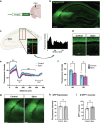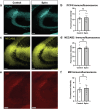Prenatal exposure to the mineralocorticoid receptor antagonist spironolactone disrupts hippocampal area CA2 connectivity and alters behavior in mice
- PMID: 39237618
- PMCID: PMC11631951
- DOI: 10.1038/s41386-024-01971-7
Prenatal exposure to the mineralocorticoid receptor antagonist spironolactone disrupts hippocampal area CA2 connectivity and alters behavior in mice
Abstract
In the brain, the hippocampus is enriched with mineralocorticoid receptors (MR; Nr3c2), a ligand-dependent transcription factor stimulated by the stress hormone corticosterone in rodents. Recently, we discovered that MR is required for the acquisition and maintenance of many features of mouse area CA2 neurons. Notably, we observed that immunofluorescence for the vesicular glutamate transporter 2 (vGluT2), likely representing afferents from the supramammillary nucleus (SuM), was disrupted in the embryonic, but not postnatal, MR knockout mouse CA2. To test whether pharmacological perturbation of MR activity in utero similarly disrupts CA2 connectivity, we implanted slow-release pellets containing the MR antagonist spironolactone in mouse dams during mid-gestation. After confirming that at least one likely active metabolite crossed from the dams' serum into the embryonic brains, we found that spironolactone treatment caused a significant reduction of CA2 axon fluorescence intensity in the CA1 stratum oriens, where CA2 axons preferentially project, and that vGluT2 staining was significantly decreased in both CA2 and dentate gyrus in spironolactone-treated animals. We also found that spironolactone-treated animals exhibited increased reactivity to novel objects, an effect similar to what is seen with embryonic or postnatal CA2-targeted MR knockout. However, we found no difference in preference for social novelty between the treatment groups. We infer these results to suggest that persistent or more severe disruptions in MR function may be required to interfere with this type of social behavior. These findings do indicate, though, that developmental disruption in MR signaling can have persistent effects on hippocampal circuitry and behavior.
© 2024. This is a U.S. Government work and not under copyright protection in the US; foreign copyright protection may apply.
Conflict of interest statement
Competing interests: The authors declare no competing interests.
Figures





References
-
- Diamond DM, Bennett MC, Fleshner M, Rose GM. Inverted-U relationship between the level of peripheral corticosterone and the magnitude of hippocampal primed burst potentiation. Hippocampus. 1992;2:421–30. - PubMed
-
- Oitzl MS, de Kloet ER. Selective corticosteroid antagonists modulate specific aspects of spatial orientation learning. Behav Neurosci. 1992;106:62–71. - PubMed
-
- ter Horst JP, van der Mark MH, Arp M, Berger S, de Kloet ER, Oitzl MS. Stress or no stress: mineralocorticoid receptors in the forebrain regulate behavioral adaptation. Neurobiol Learn Mem. 2012;98:33–40. - PubMed
-
- McEwen BS. Steroid hormones: effect on brain development and function. Horm Res. 1992;37:1–10. - PubMed
MeSH terms
Substances
Grants and funding
LinkOut - more resources
Full Text Sources
Miscellaneous

